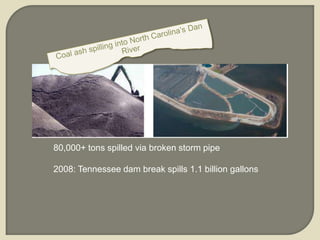
Chapter 18
- 1. Options: washing away air pollution with artificial rain ?sucking it up with giant vacuum cleaners ? Shanghai has given its cops nose insert mini-filters A study published in the British medical journal the Lancet attributed 1.2 million premature deaths in 2010 to bad air
- 2. Types and behavior US pollution Distribution Carbon cycle and weather Ozone & acid rain cases Solutions
- 3. Gaseous pollutants CO and CO2 SO2 NO, NO2 [NOx ] O3 and CFCs – [chlorofluorocarbons] Particulates Soot, ash, & smoke Dust (released from industrial processes) Not a minor component - from 35 million tons/year (mainly combustion) to 180 million tons/year (mostly industrial) Residence times vary widely, from a few years to millions of years – related to amount in the atmosphere, so N & O hang around longest
- 4. CO2 - carbon dioxide - combustion, and natural like respiration, volcanic eruptions Varying residence time and fluxes Rapidly, steadily increasing CO – carbon monoxide – vehicles, combustion Not abundant but deadly Very short residence time – fluctuating concentration SO2 - sulfur dioxide – from combustion of coal forms acid rain – pH << 6 very short residence time (days or hours) Mostly decreasing at least in US NOx – nitrogen oxides – “smog ozone” interacts at several levels reacts in sunlight to form opaque NO2, + ozone (O3), acids, etc Emissions steadily increasing VOC – volatile organic compounds – breakdown products of industrial process, plastics, petroleum, etc
- 5. $16 billion annual U.S. expense (direct costs) vs $40B globally Major gas sources: Transportation: [1] CO, [1] NOx, [1] VOC, [1] CO2 Energy: [1] SO2, CO2,NOx Industry: VOC, SO2, CO2 Transportation ranks first in several categories Particulates are heavily influenced by industry, greatly reduced in recent years
- 6. Comparing two classes shows complex, interesting history Sulfur Nitrogen
- 7. Comprised of sources and sinks CO2 and CO are emitted and travel through this cycle Combustion and other emissions greatly alter the proportions Major effects: greenhouse gases, plant building, hydrocarbon formation These gases interact with lithosphere, biosphere and hydrosphere in often complex chemistry Other compounds have similar cycles, sources and sinks
- 8. Thermal Inversion Warm, polluted air tends to rise, cooling as it goes a cool air mass can have an overlying air mass trap the rising warm pollutantbearing air mass; this condition is made worse by an air mass with stagnant conditions Pollutants are concentrated in the lower air mass and trapped, yuk! Topography, climate may amplify the problem
- 9. Ozone (O3) is a „chemically out of place pollutant‟ – good high up, bad low down In upper atmosphere the ozone layer absorbs harmful ultraviolet radiation Chlorine and fluorine are chemically active ions that rip O3 apart & reduce O3 concentrations Recently, banning CFCs has returned ozone to upper atmosphere
- 10. An acid solution has more Hydrogen-ions (H+) – measured in pH Several common gases combine with water and air to make acids Acid rain is harmful to plants, health of rivers and lakes, and animals – also causes increases in the build up of heavy metals (lead, zinc, selenium, copper, and aluminum) leached from rocks and soils
- 11. Global solutions
- 12. Air Quality Standards – Clean Air Act (1970) strong legislation that created the EPA - Environmental Protection Agency Regulations cover catalytic converters and high fuel economy standard for new cars Result: dramatic reduction in emissions, especially the most harmful categories
- 13. Thanks for taking a look at the Environmental Geology slides!
